| qualitas1998.net
|
«FIGIPAS 2009: A Smashing Success»
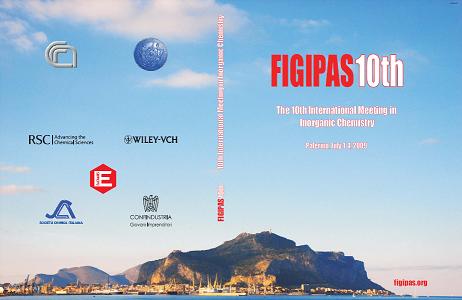 About
300 scientists, including chemistry professors,
postdocs and graduate students from 43 countries mingled
in Palermo early
this July right next to the picturesque gulf of Palermo,
in the magnificent setting of the Art nouveau Villa
Igiea, for the 10th FIGIPAS
Meeting in Inorganic Chemistry
jointly organized by Italy' Cnr and Palermo's University on July 1
through 4, 2009.
Over 300 Conference delegates came to Palermo from Israel and Iran;
Russia and the US; South Africa and Malaysia; as
well as from tens of other countries pointing to the international
nature of the conference, once mainly attended by European scientists.
About
300 scientists, including chemistry professors,
postdocs and graduate students from 43 countries mingled
in Palermo early
this July right next to the picturesque gulf of Palermo,
in the magnificent setting of the Art nouveau Villa
Igiea, for the 10th FIGIPAS
Meeting in Inorganic Chemistry
jointly organized by Italy' Cnr and Palermo's University on July 1
through 4, 2009.
Over 300 Conference delegates came to Palermo from Israel and Iran;
Russia and the US; South Africa and Malaysia; as
well as from tens of other countries pointing to the international
nature of the conference, once mainly attended by European scientists.
Photo Gallery
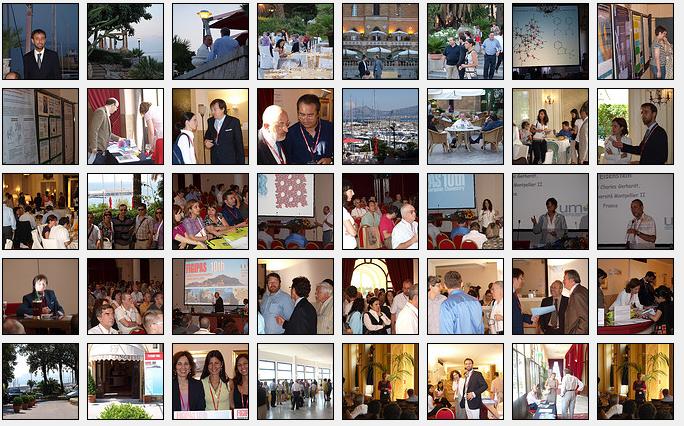
The vice president of Palermo’s provincial Government Piero Alongi opened the meeting.
"Science and innovation are the keys to make sustainable our development everywhere in the world and particularly in Sicily said at the opening ceremony on July 1st.
"We are pleased to host all of you in Palermo". Members of the conference International Advisory Board Maurizio Peruzzini, from Florence’s Cnr, thus told the story of the FIGIPAS series of bi-annual Conference that has been bringing together leading researchers and young scientists since 1991.
There were no restricted speaker lists”, explained the conference chairman Mario Pagliaro, “and in selecting the oral speaker we selected senior scientists in good balance with young, bright scientists who are clearly on their way to the top, but not yet there”.
People of the Organizing Committee did an exceptional job, providing timely assistance to delegates and successfully achieving the complex tasks of a job entirely carried out by members of the Organizing Committee Marzia Sciortino, Giovanni Palmisano, Piera Demma Carà, Vittorio Loddo and Sedat Yurkadal co-ordinated by Rosaria Ciriminna.
Heinz Krebs of BookofAbstract.com produced in Vienna the elegant and functional Book of Abstract of the conference. The Young Entrepeneurs of Palermo's Industrialists Union was the main conference sponsor (Americanelements.com donated nice periodic table magnets).
The Meeting
This year, the conference featured some 8 plenary lectures, 51 oral presentation (16 of which invited) held in two parallel sessions and 192 poster presentation. The 10th FIGIPAS edition was the last meeting of the FIGIPAS series that will now become the inorganic chemistry conference of EuChemS whose inorganic chemistry board met in Palermo right during the conference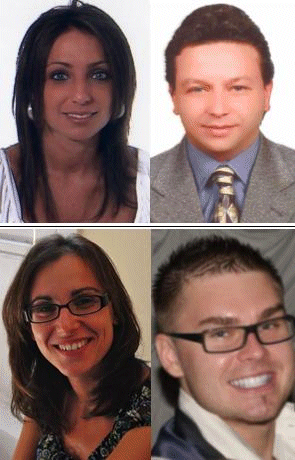 .
.All presentation were met with great interest and the conference plenary hall was still crowded by delegates on the very last day on the morning of Saturday July 4th when Preeti Vashi (Deputy editor of the European Journal of Inorganic Chemistry) awarded 4 poster prizes of €300 each to the prize winners:
- Amanda Alonso from the University of Barcelona ("Donnan-Exclusion-Driven Distribution of Catalytic Ferromagnetic Nanoparticles Synthesized in Polymeric Fibers")
- Roberta Bomparola from London Imperial College ("Structure-Reactivity Relationships in New Organocuprates")
- Oguzhan Avciata from Yildinz Technical University ("Synthesis and Application of V2O5 Doped Nano TiO2")
- Pavel Dub from France’s Lab of Coordination Chemistry at Lyon’s Cnrs ("Mechanistic Study of the PtBr2-Based Hydroamination of Ethylene with Aniline").
Ira Weinstock, a professor at the Ben Gurion University of the Negev, whose work on polyoxometalates (POMs) was recently featured on the cover of JACS -- gave a wonderful talk on the versatile chemistry of POMs showing for the first time the latest findings from his group on double layer particles.
Along with coordination and supramolecular chemistry, this year’s conference also has renewable energy and global sustainability as themes, and keeping with that, Athanasios Konstandopoulos, the father of the solar hydrogen technology through direct water splitting with concentrated solar light, spent his slot on stage giving a wonderful slide presentation on feasibile solar energy and abtament of pollutants in combustion exhaust gas.In brief, he concluded, we must transform our economics into a true Helionomics. A term for which I must credit Mario for having been the first to use the word in his book.”
French theoretical chemist Odile Eisenstein showed the achievements of computational approach to inorganic chemistry, including Tungsten hydride compounds that were thought to be “absurd” and whose structure was later shown to be exactly that calculated by her Group; Hebrew University of Jerusalem's chemistry professor David Avnir illustrated the discovery of chiral zeolites showing the potential of the continuous symmetry measurement (CSM) approach also in inorganic chemistry.
Lisboa Technical University's Laura Ilharco gave a splendid plenary lecture on sol-gel entrapped Ru-complexes with purine ligands. And Vienna's University of Technology Karl Kirchner gave a talk of similar standing on iron pincer complexes.
University of Naples' chemist Carlo Pedone discussed the striking biochemistry of the small peptide QK and described its forthcoming entrance into clinical phase; Spain's Victorio Cadierno reported the latest achievements of the employment of Ru-based catalysts in olefin methatesis; Edit Tshuva, from the Hebrew University of Jerusalem, did the same for titanium complexes and University of Milan's Renato Ugo showed the non centrosymmetric complexes for non linear optical applications. "I was used to play with my grandmother exactly on the stairs of this Villa some 50 years ago. -- Professor Ugo told delegates opening his talk -- Needless to say, I am particulary happy to give my talk in the city where I was born".
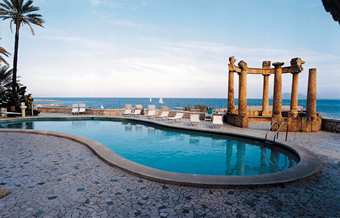 Canada’s chemist Bruno Therrien (now
in Switzerrland)
illustrating the chemistry of Ru cubane complexes gave another example
of how the the nanochemistry approach is eventually realizing the
promises of nanotechnology.
Canada’s chemist Bruno Therrien (now
in Switzerrland)
illustrating the chemistry of Ru cubane complexes gave another example
of how the the nanochemistry approach is eventually realizing the
promises of nanotechnology.University of Trieste's Paolo Fornasiero explained the use of new catalysts for entirely clean chemical manufacturing processes, including the use of novel embedded Pd@CeO2 catalysts (related research paper due for publication in a forthcoming issue of Dalton). New University of Lisboa's Ricardo Louro reported the latest findings on the respiratory chains of metal respiring organisms.
Professor Rodrigue Lescouzec from Paris University showed the large potential of solid-state NMR in relsolving delicate structural details in inorganic compounds such as Prussian Blue.
Antoni Llobet, a chemistry professor at Spain's Tarragona Institute of Chemical Research of Catalonia, presented the latest results on oxygen-oxygen bond formation pathways promoted by Ru complexes. South Africa's University of Cape Town professor Gregory Smith presented the synthesis, characterisation and biological activity of new Palladium thiosemicarbanzones.
Russian Academy of Sciences scientist Andrey Semioshkin gave an excellent presentation on the chemistry of cyclic derivatives of closo-dodecaborate anion.
Many other remarkable talks and several excellent poster presentation addressed a number of topics in modern chemistry. The cross-disciplinary nature of contemporary chemical research clearly emerged from the conference presentation, no matter if oral or poster.
Scientific Papers in Dalton Transactions
Dalton Transactions, the prestigious journal for inorganic chemistry of the Roayl Society of Chemistry, will publish papers originating from the 2009 FIGIPAS meeting. Submitted papers would be subject to peer-review, and if accepted, will be published with a footnote. The Journal's editorial team will then create a web page on the journal website that collects these papers together.The Journal's Editor, Jamie Humphrey, personally attended the conference.
A selection of free articles in Chemical Communications and in Dalton Transactions describing work related to the topics covered at FIGIPAS were collected online on the RSC website.
Social Program
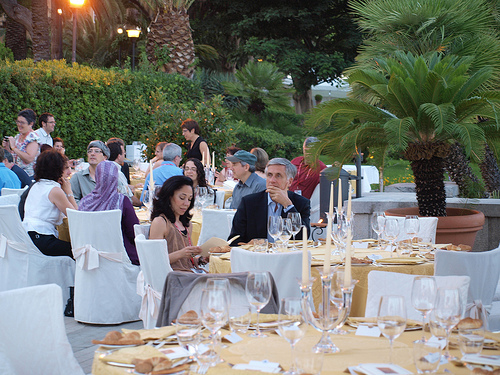 An
exquisite gala dinner was serviced to the conference
delegates in the terrace in front of
Palermo’s sea at Villa Igiea, on the evening of July 2nd.
An
exquisite gala dinner was serviced to the conference
delegates in the terrace in front of
Palermo’s sea at Villa Igiea, on the evening of July 2nd.FIGIPAS conference delegates spent the afternoon of July 3 on a tour of Palermo’s Royal Palace that included parts of the Palace that are usually closed to the public, upstairs to the so called "Camera dello Scirocco"; then visiting Palermo's Cathedral and ending the tour in the immense dome of Monreale, a magnificent church dating back to 12th century.
Feedback
"We had an unforgettable time in Palermo” wrote to the chairman Patrina Parsekvopoulou and Konstantin Mertis, a chemistry professors at the University of Athens, “Our congratulations should be extended to the guys at the registration desk, who made their best to assist everyone and for whatever reason”."Your efforts and organization were fantastic and I really enjoyed the talks," said João Costa Pessoa, a chemistry professor at the Universidade Tecnica of Lisboa, in Portugal. “Thanks for the organization of the excellent conference held in such a nice place" he concluded.
“Congratulation on an excellent conference, which was well done, and very worthwhile in all respects”, added Ira Weinstock.
"Congratulations for the great event -- wrote Camilo Javier Viasus from Bogotà -- For us this experience were really rewardingMany thanks for all your help in our stay".
"I enjoyed very much my stay at Palermo and I was very happy to meet you. Hoping to see you all in Argentina", echoes Professor Luis Federico Sala from Rosario's University.
"Thank you for everything and congratulations for your achievement -- added Laura Ilharco -- It was excellent. To Rosaria, Giovanni and all the crew, a big Bravo."
"Back in Heraklion, we are full of beautiful memories from Palermo, and FIGIPAS, thanks for your hospitality" remarked Athanassios Coutsolelos.
"This conference -- concluded professor Regis Reau, from Rennes University -- was a great scientific success and I enjoyed very much the different lectures. Congratulations for this very successful conference".
Further information
Dr M. Pagliaro (mario.pagliaro@cnr.it) - Prof. L. Palmisano (leonardo.palmisano@unipa.it)Back to the MPL Home-Page